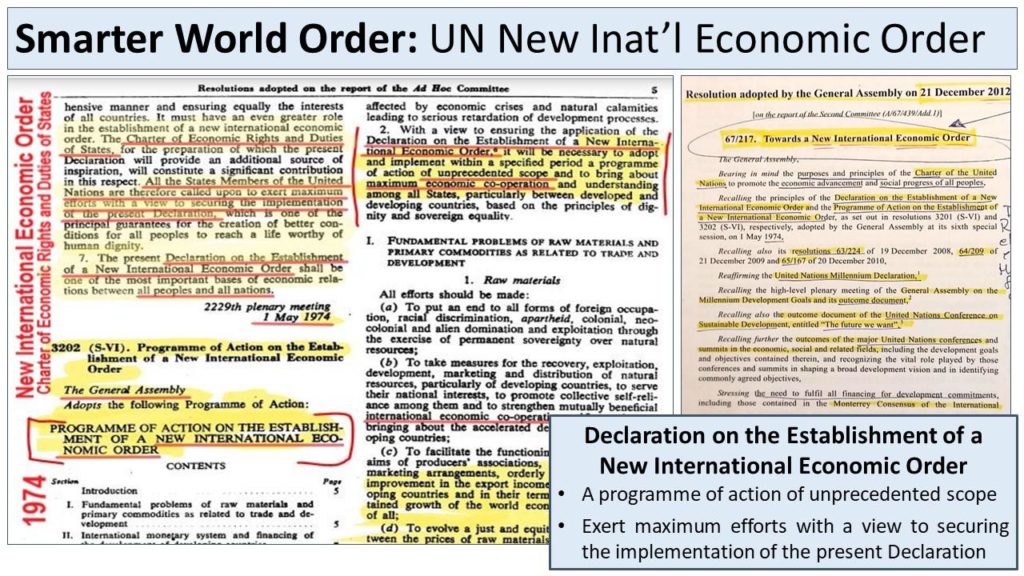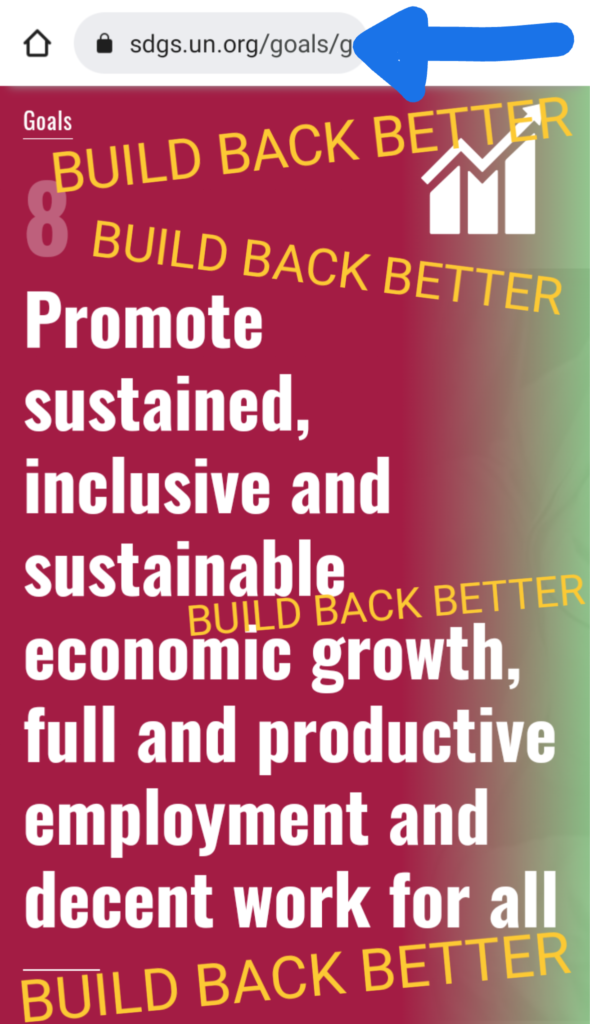
Comprehensive plans are tools adopted by government, its agencies, partners, and/or proxies (including task forces, working groups, stakeholder councils, community organizations, civil society partners and the like) to establish the language, goals, and strategies for transforming all aspects of existing social, political, and economic structures and their operations to conform to the United Nations’ 1974 Resolution on Establishing a New International Economic Order (NIEO).

In 1992, the contours of the NIEO were elaborated and specified as Sustainable Development, or Agenda 21, and in 2015, its programmatic vision for the reinvention of society, politics, and the economy was crystallized into 17 Global Goals in the 2030 Agenda.

The NIEO and its Sustainable Development Goals are the impetus behind myriad change-oriented policy frameworks and have many monikers to appeal to a variety of audiences. Among the most familiar iterations of the NIEO are “Smart Growth” policy, advocated by academic and non-governmental organizations, the World Economic Forum’s (WEF) “Great Reset” manifesto (“Reset,” for short) and the “Build Back Better” (“BBB”) efforts currently underway by governments across the world. In order for the NIEO to replace the status quo, it must be established at local, regional, and national levels of government, and it must become the governing rubric for all sectors of human interaction and organization.
Comprehensive plans are the mechanisms for manifesting the NIEO throughout the various levels of government and society, especially at the level of local government and public services administration.
The following bullet-point list summarizes the essential features of a comprehensive plan. It is copied from a paradigmatic example of comprehensive planning, the Moving McAlester Forward plan for 2040, developed by Guernsey, Nealon Planning, Butzer Architects and Urbanism, and adopted by the City of McAlester, Oklahoma. All comprehensive plans – regardless of location or sector – follow this template.
A comprehensive plan:
• provides a common framework for addressing issues pertaining to growth and development
• seeks to strike a balance among the many competing demands on land resources by creating development patterns that are orderly and rational, provides the greatest benefits for individuals and the community as a whole and avoids nuisance conflicts between land uses
• will help the community protect public investments since well-planned, orderly, and phased development patterns are less expensive for a community to provide with public services than low-density, scattered development
• will allow this community to plan development in a way that protects valued resources such as identified environmental features
• provides guidance for shaping the appearance of the community and fosters a sense of place
• promotes economic development
• provides an objective basis to support zoning and other decisions, particularly if legally challenged
–Adapted from definition authored by Gary D. Taylor, Iowa State University[1]
Comprehensive planning is taught in colleges, universities, professional schools and training institutes, and leadership-development organizations. It is advocated by high-level, well-endowed, and influential think-tanks and non-governmental organizations (NGOs) and by proponents of globalization and sustainability in both the public and private sectors. Although comprehensive planning may be adapted to suit particular circumstances, its overall approach and aims are conspicuously uniform regardless of who promotes it or where it is taught or implemented. This is because comprehensive planning follows the United Nations’ template for establishing the NIEO.
[1] Moving McAlester Forward Comprehensive Plan 2040. Prepared for John Browne, Mayor of McAlester by Guernsey, Nealon Planning, and Butzer Architects and Urbanism, and adopted September 25, 2019. PDF available here.
The following terms are of particular importance in comprehensive planning documents and are evidence of the Reset template:
• Quality of Life / Vibrant City – these phrases indicate that the aim of the plan is to promote the 17 UN Sustainable Development Goals through the delivery of publicly-funded services and social interventions (e.g., healthcare, education, workforce development, housing, etc.) that are continuously monitored in order to determine “impact” – the measurable change from a pre-intervention baseline situation to a post-intervention situation. The new economy is based on a shift “from fixed capital to human capital” – in other words, from trading in goods and services to trading in human behavioral outcomes. Therefore, progress toward the SDGs (quantified in an impact report) is analogous to the change in price of a share of stock in a publicly-traded company. The new economic order is based on value-creation through improvements to individual and community quality of life.
• Economic Development – this phrase denotes a developed economy that conforms to the new international economic order in being globalized, privatized, and data-driven. At the highest levels, the designers of the new economy are financial industry owners and executives who incentivize public- and private-sector agents to implement it. Economic development policies prioritize targeted industries and sectors and align all resources – natural, physical, social, and human – toward their economic advantage.
• Innovative Financing – this phrase signals the shift from public funding (i.e., tax revenues, which are subject to public oversight) to private investments or a mix of public and private contributions. Green Bonds and infrastructure bonds are common examples. Most innovative financing mechanisms (public debts) are secured on the basis of projections of future-growth or future-savings (cost offsets). The risk of under-performing investments is shouldered by the public, while the reward of well-performing investments belongs to the private sector.
• Fiscal Responsibility – an approach to “rational, well-designed” planning that prioritizes the “best use” or “targeted use” of financial resources to develop or maintain existing assets such as infrastructure and land, according to future projections of economic growth and operational efficiency. In plain terms, this means that comprehensive planners have a vision for a specific development scenario (compact, high-density, mixed-use developments clustered around shared transportation hubs), and they use fiscal policy to control the supply of infrastructure (e.g., water service lines, roads, other utilities) so that development must occur within the parameters of that vision.
• Placemaking / Neighborhood Identity – this is a strategy to create a narrative that governs what people think and how they feel about a particular place. It is designed to create pockets of special identity through an array of branding, public art and cultural offerings, historic preservation, micro-localization, design and building codes, and other mechanisms to “foster a sense of place” and create “unique destinations” and “eco-tourism” as drivers of employment. Moreover, these strategies encourage residents to prefer to stay-in-place rather than cross district lines and provide a justification for restrictions on activities and enterprise that fails to conform to the established vision. Paradoxically, the implementation of Universal Design Principles, Green Building Standards, and Inclusive Cultural Experiences factor heavily into placemaking strategies.
• Connectivity – this term designates the imposition of a systems-wide approach to measuring and managing all resources, especially transportation/mobility options and the exchange of information through communications technologies. Broadband infrastructure, street design, supply chains, and social and cultural opportunities are key areas of introducing connectivity into the larger “ecosystem” of “human settlements” and balancing 1) economic growth with environmental protection, and 2) individual interests with the “needs of the community.”
Here is a link to a presentation I gave on comprehensive planning and smart cities:
The slide deck and supporting documents are available here:
https://drive.google.com/drive/folders/1OP69appDtnJfG4y9ubCEbBJzZacXk026